Extracurricular activities are an essential aspect of the IMSA experience. There are a number ways for students to pursue their interests outside of the classroom with like-minded individuals. In recent years, IMSA administration has noticed a problem with the organization and regulation of club management.
One of their solutions to this problem is the Presence platform.
According to the Coordinator of Student Leadership and Service Emma Wilson’s email sent in January, Presence is the newly implemented form of club management at IMSA. Many IMSA students have questions about what Presence is, what it offers, and the like, so The Acronym interviewed Emma Wilson and the Coordinator of Campus Activities, Chloe Katehis, to learn more about the transition.
What is Presence?
In an interview on January 30, Wilson and Chloe Katehis, Coordinator of Student Activities, explained that Presence was implemented to improve communication between clubs and the student body. There was simply no standardized device for organizing event information, which led to clubs having to rely on Facebook, posters, and the dreaded student-l emailing list that sends its messages out to all students.
Why now?
The “switch” to Presence is not as abrupt as one might believe. On July 21, 2021, IMSA signed a three-year contract with Presence. In fact, current Juniors and Seniors had known about Presence since last year when IMSA’s Student Council, or StudCo, was tasked with exposing students to the system, which was ultimately pushed to the side because students lacked the influence or time to fully implement it. This year, Wilson and Katehis led the charge to widely implement Presence with the mindset that change will not occur unless it begins now.
What was wrong before?
The previous club management organization’s biggest problem was an overflow of information.
Students often receive more than one hundred emails per week due to the number of clubs and student organizations on campus. Because of the sheer volume of emails received, the student body has become desensitized to the amount of information received and frequently deletes emails without reading their contents. Furthermore, student-l emails must be manually accepted by Student Life before they can be sent out, which is difficult for time-sensitive events and causes a batch of emails to be delivered at once, contributing to the amount of information overload students receive.
Furthermore, with such a large influx of information, it was difficult to filter out the truly important opportunities that IMSA has to offer. It is difficult to receive information when the first thought is to delete, whether it is scholarships sent out by the CAC (Career and Academic Counseling) office, competitions by Entrepreneurship & Innovation Program Manager Steve Goldblatt, or service learning opportunities by Wilson. There simply was no filtration system.
Another significant issue was that club leaders were not held accountable. Club leaders had almost complete authority over their organization, with the only stipulation being that they request money from StudCo and hold two events per semester. This year, the general consensus is that club leaders aren’t entirely sure of their responsibilities. This is especially problematic because StudCo’s only fundraising event is homecoming, which means they only have one event to fund StudCo chartered clubs throughout the entire year.
What are the benefits of Presence?
The more significant benefits Wilson and Katehis describe are localization and analytics.
Everything is in one place with Presence. A club’s page contains a wealth of information in an easily accessible format. If a student wants to learn more about a club, they can access an About page with the click of a button. If a student wants to contact a club leader for a potential collaboration, they can access that information with another click of a button. Presence’s ability to post events in a calendar and create forms using the app are two very important features. IMSA students enjoy gauging interest and informing the student body about upcoming events. Instead of cluttering everyone’s inbox, Presence keeps everything in one localized area platform, making it easier for students and club leaders to organize events.
Another significant advantage of using Presence is that it enables club leaders to track analytics. Presence can track who attends events, which is useful in determining potential board candidates and how many events a club has had. There is even a feature that tracks if there are any unique members, or new members who have not previously attended a club’s events, who have come to an event. This not only allows club leaders to see which events are the most successful and popular with the student body, but it also holds club leaders accountable. Clubs should start to use this feature this year, as it will be a requirement for all events for the 23–24 school year.
The club funding system was loosely regulated last year, which resulted in a few instances that could have been avoided. Presence allows administration and board members to see the impact they had on the student body, which is important in deciding whether a club requires a certain amount of funding, but it also provides data for external sources to see the work clubs do at IMSA and their impact on the student body.
Furthermore, Presence is a viable option for incorporating general membership into clubs. One of the administration’s long-term goals is to reduce club power consolidation by limiting the number of leadership roles in high-commitment activities and expanding general membership opportunities. Presence is a great way to do this because it allows users to post questions about it and more.
What are some of the drawbacks?
One of the major disadvantages of Presence is that it is still in its early stages. There are bound to be software glitches with new things, such as, in some cases, Presence not being accessible with older versions of phones due to the scale. The app also does not yet support push notifications, which is a major inconvenience.
Another disadvantage of Presence is that it is a significant change. Something could be gradually incorporated into the framework with minor changes, but switching to an entirely new platform necessitates the use of all students. Without student input, proper troubleshooting to improve the software is impossible.
Using Presence also has a significant learning curve. However, Wilson and Katehis share that since that IMSA had adopted a non-mainstream software, it allows them to directly communicate with the company in order to implement changes that will benefit the student body.
What is the future of Presence?
Wilson and Katehis stated that the student body was critical to the future of Presence. One of the solutions proposed to improve club management is Presence, but it is not the only one. IMSA currently has a 3-year contract with the company, but if it does not work out, IMSA will look for a new alternative. Because Presence has so many different features and so much potential, Ms. Chloe and Ms. Emma recommend that students just play with it. Spend 5–10 minutes on it during lunch, maybe tinker with it a little during off-mods, but just play around with the various features.
Student Input
Although Presence at IMSA was officially launched a few weeks ago, club leaders and StudCo have had their own experiences with it throughout the year.
Club Leaders
The overwhelming consensus about Presence was that it was being implemented too quickly and that clubs’ needs were not being met to accommodate the change. Club leaders had to deal with more red tape to lead events this year than they had to in previous years but because the transition to Presence felt (and perhaps, was) so fast it led to confusion.
StudCo
StudCo seemed upbeat about using Presence from an interview with Tate Schneider, 1503 Hall Senator. He agreed with Wilson, explaining that Presence would reduce the number of student-l emails received and create a more organized system for managing extracurriculars. He said it would also allow club leaders to plan events in accordance with other major events on the calendar (e.g., it would be unwise to plan an event during a culture show week).
How to Use Presence
Now that you understand what Presence is, you should learn how to use it.
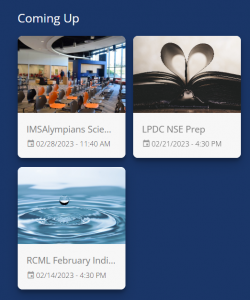
Presence “Coming Up” Section | Source: David Dickson
Desktop App
Presence’s desktop application can be found here. When you open Presence, you will be prompted to log in with your IMSA credentials, which will take you to the home page.
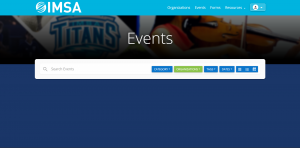
Presence “Events” page | Source: David Dickson
Scrolling down, you’ll see text boxes for your memberships, Presence’s mission statement, all IMSA organizations, and the coveted calendar.
The calendar displays upcoming events in a convenient and easy-to-access format.
There is also a taskbar above that displays options such as “Organization,” “Events,” “Forms,” and “Resources.” As a club leader, you can customize your page to include information about your club, add events to the universal calendar, and more.
Presence is one solution to improve club management, but it is up to us students to push the project forward and see if it is the best option for our school.

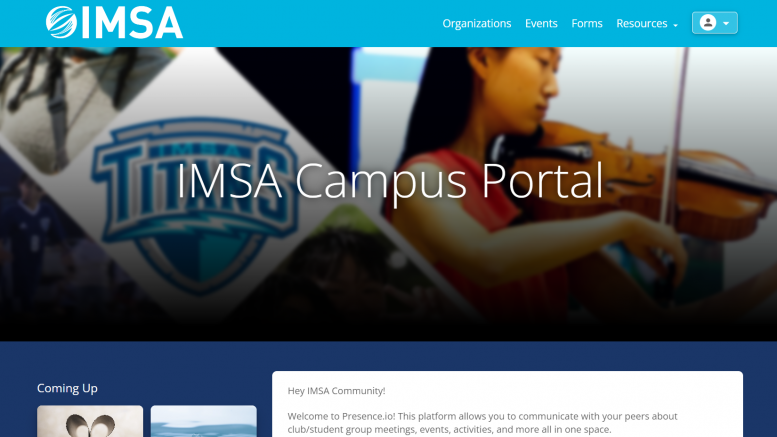
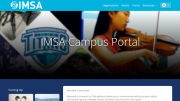
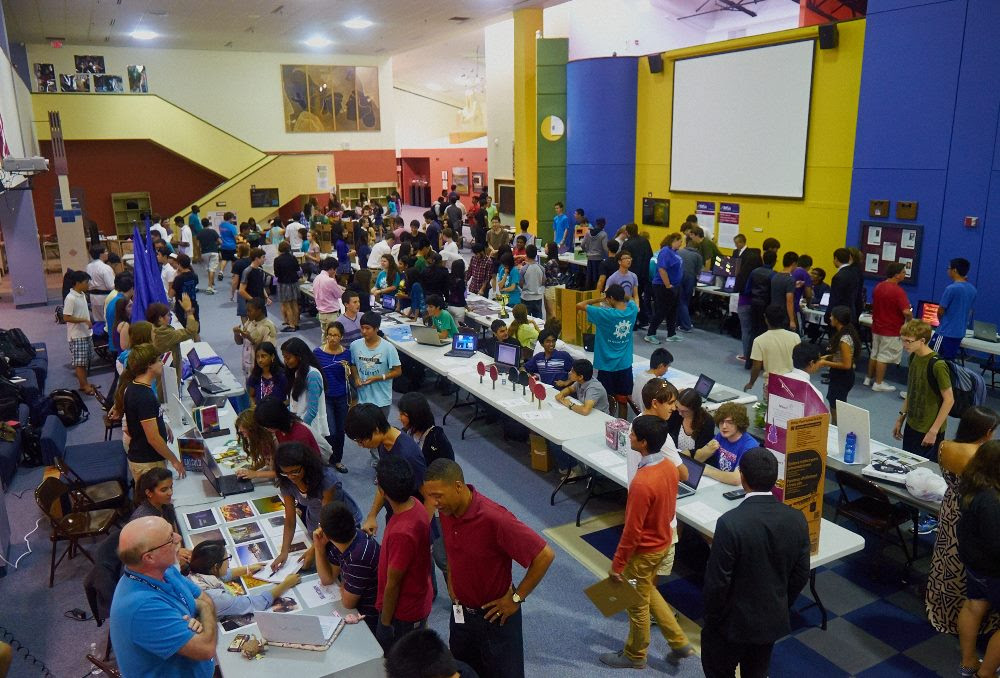


Be the first to comment on "IMSA’s Clubs Transition to Presence.io"